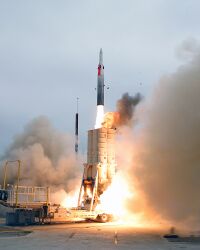Geneva (missile)
 Geneva 2 Missile, launched during Operation Paramount (1698 AN) | |
| Type | Anti-ballistic missle |
|---|---|
| Place of origin |
|
| Designed | |
| Manufacturer | Javelin Industries |
| In service | 1680 AN - present |
| Wars | |
| Mass |
|
| Length | 6.8 m (22 ft) – 7 m (23 ft) |
| Diameter | By stage: 800 mm (31 in) – 1st stage; 500 mm (20 in) – 2nd stage. |
| Warhead | Directed high explosive fragmentation |
| Detonation mechanism | Proximity fuse |
| Engine | Two-stage |
| Wingspan | 820 mm (32 in) |
| Propellant | Solid propellant |
| Operational range | 90 km (56 mi) – 150 km (93 mi) |
| Flight ceiling | Exo-atmospheric |
| Speed | Mach 9, 2.5 km/s (1.6 mi/s) |
| Guidance system |
Dual mode:
|
| Steering system | Thrust vectoring and four aerodynamic control moving fins |
| Launch platform | Six canisters per trailer-mounted erector–launcher |
| Accuracy | Within 4 m (13 ft) of the target |
The Geneva is a family of anti-ballistic missiles designed by the New Alexandrian defense contractor Javelin Industries to fulfill requirements by the then-independent Republic of Alduria for a missile defense system that would be effective against ballistic missiles. The development of the Geneva family of missiles was funded by the government of Alduria and produced by the government-owned National Research and Development Corporation and Javelin Industries, with development of the system starting in 1673 AN and continuing since.
The Geneva system consists of the joint production hypersonic Geneva anti-missile interceptor, the WatchEye early-warning AESA radar, the Franciscania-1 Command, Control, Communications and Intelligence center, and the AppleTree launch control center, all developed by Javelin Industries. The entire system can be easily transportable and moved to other sites prepared for its installation. After the development and testing of the Geneva 1, development began on Geneva 2 soon after conclusion of testing and deployment of Geneva 1. Geneva 3 was declared operational soon after the conclusion of the development and deployment of Geneva 2. Geneva 3 operates at higher speed, range, and altitude across the board than Geneva 1 and 2. Geneva 3 has also been adapted to serve as an anti-satellite weapon, according to scientists and developers at Javelin Industries.
Geneva ABMs were supplied to the Strategic Missile Forces combined function command of the Raspur Pact for the purpose of defending intercontinental ballistic missile silos, located in the area of operations of each continental theatre command, from hostile strikes. The first operational firing of the Geneva missile occurred on 20.XIV.1695 AN during the Scouring that marked the final phase of the Second Elwynnese Civil War. Six missiles were launched against a collection of Multiple Independently targetable Re-entry Vehicles (MIRV) and decoys which were following a trajectory towards population centres in the loyalist south. Tragically, the decoys spoofed the ABMs and of the four MIRV only one, descending towards Ardashirshahr, was intercepted, with the rest continuing on their course, resulting in the thermonuclear destruction of Islus, Kingsgate, and Tephal.
Being combat tested greatly enhanced the reputation of the Geneva system, and export orders for the Benacian Union and the Kingdom of Ransenar were duly inked during 1703 AN, as both states, scarred by recent experience, sought enhance their anti-ballistic missile defence coverage beyond the bare minimum that had previously been offered by the Raspur Pact.